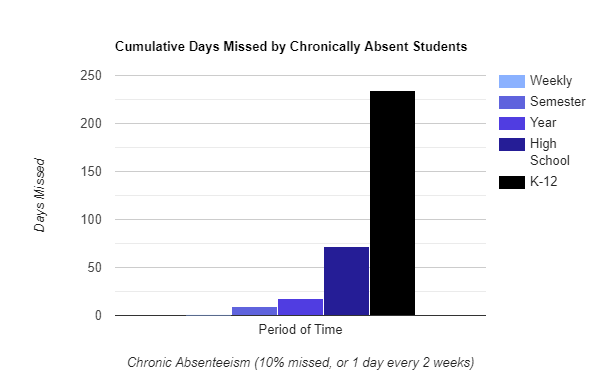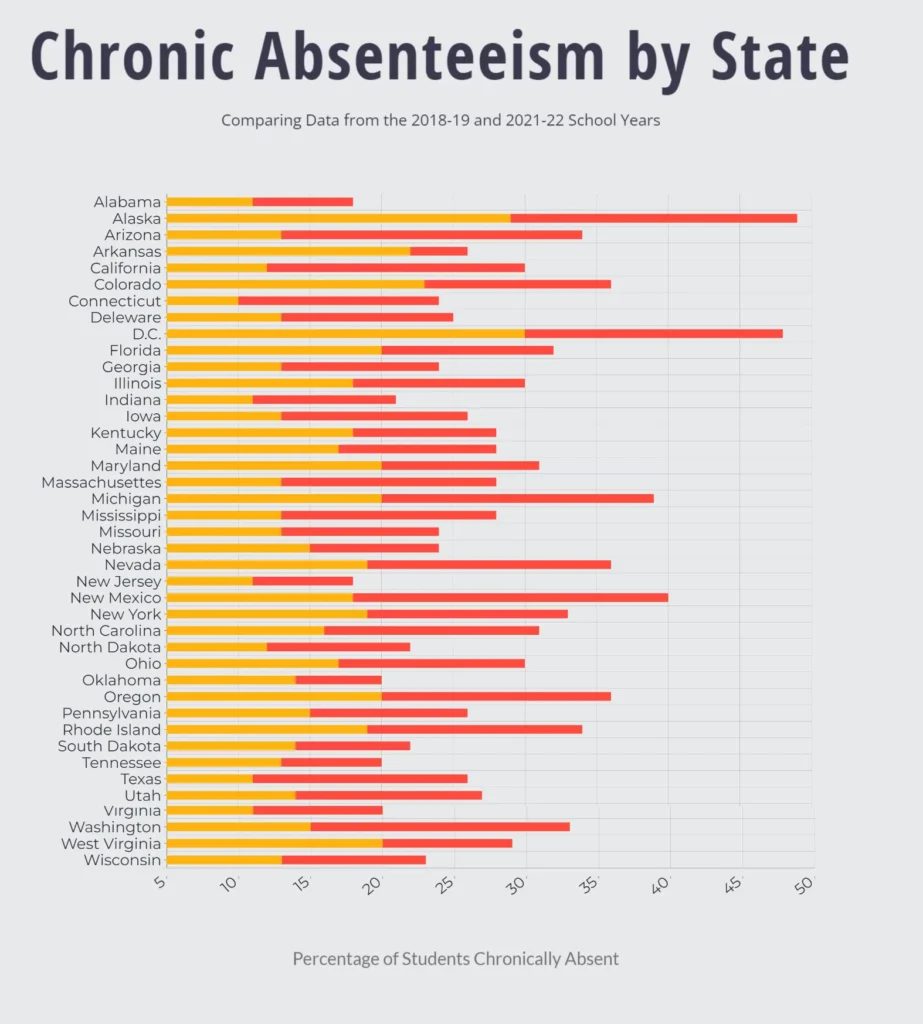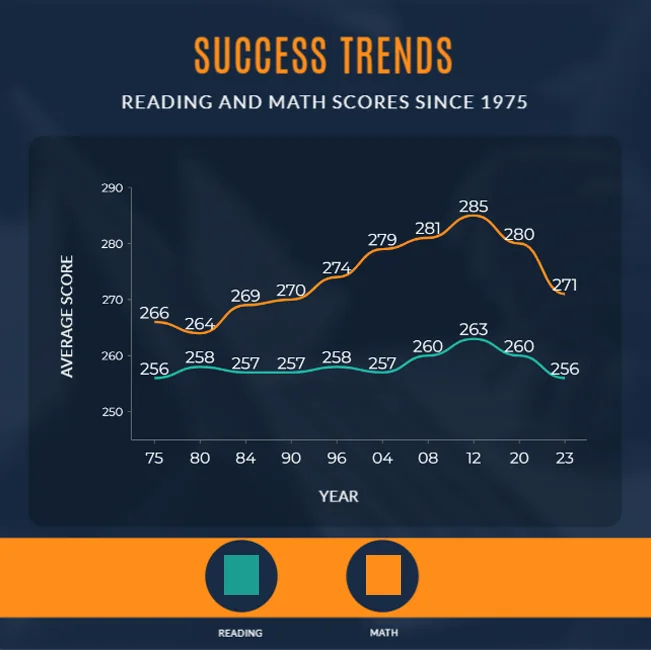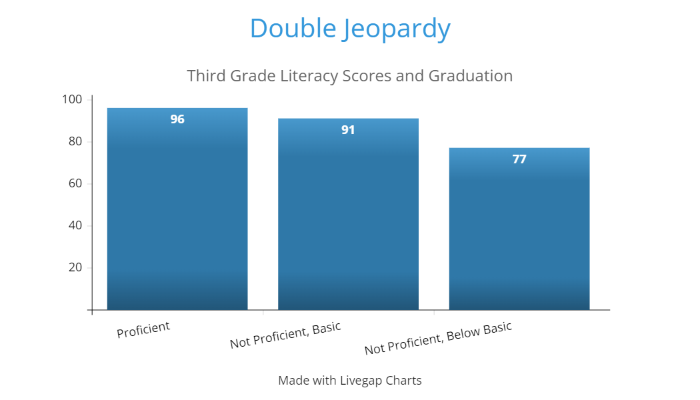In the vast tapestry of America’s education, amidst the intricate dance of teaching and learning, a seemingly invisible force is at play – chronic absenteeism. It operates in the background, unassuming yet powerful, weaving through the hallways and classrooms of schools from every echelon, leaving a trail of unanswered questions and untapped potentials. It is here, in this intersection of absence and education, that we find a fascinating conundrum, a tipping point that could shape the trajectories of countless futures.
Chronic absenteeism isn’t just a matter of empty chairs in a classroom; it’s a puzzle, a series of interconnected dots that, when connected, reveal a picture of lost opportunities, gaps in learning, and a ripple effect that alters the academic landscape. What transpires in the voids created by absenteeism? How does this unseen force engrave its mark on the academic journey, subtly shifting the narrative, reshaping outcomes?
Chronic Absenteeism: An Overview
In the sprawling and diverse world of American education, where every day brings new lessons and every classroom is a universe of potential, a silent and often overlooked presence casts a shadow – chronic absenteeism. It’s a term that, on the surface, is plainly defined: students missing more than 10% of school days. But within this simple definition, there lies a deeper, more complex story, a narrative of missed opportunities, disrupted learning, and futures hanging in the balance.

**Being absent 10% of the time equates to missing one day every two weeks. This frequency accumulates rapidly: it translates to two days per month, nine days per semester, 18 days annually, 72 days throughout high school, and a substantial 234 days—surpassing an entire school year—over an average school career. Notably, the absence rate for many chronically absent students exceeds even these figures.
A Ripple in the Educational Stream
Chronic absenteeism isn’t just an accumulation of absences; it’s a ripple in the educational stream, subtly yet irrevocably altering the course of a student’s journey. Every absence creates a void, a gap in the intricate tapestry of learning that can expand, evolve, and ultimately shape the academic experience. It’s a subtle disturbance in the rhythm of education, a quiet reshaping of the melody that composes a child’s journey through learning.
Literacy: Foundations of Understanding
Literacy is the bedrock of education, the cornerstone upon which the vast edifice of knowledge is built. Each absence creates a crack in this foundation, a missing piece in the intricate puzzle of language and understanding. The chronically absent student is like a traveler navigating a landscape with missing landmarks, the journey fragmented, the destination ever-shifting.
Numeracy: The Threads of Reasoning
Similarly, when we explore the world of numeracy, where logic forms the threads of reasoning and every number is a step in a dance of analysis, we find absenteeism to be a silent disruptor. Every missed class is a missing link, a break in the chain of logical progression, making the dance of numbers more challenging, the rhythm more complex. The student, in the shadow of chronic absenteeism, is piecing together a puzzle with missing parts, the image incomplete, the resolution elusive.
Graduation: The Culmination of a Journey
When we reach the realm of graduation rates, the culmination of an academic journey, the influence of chronic absenteeism becomes even more tangible. The path to graduation is not a sprint but a marathon, a journey marked by milestones and challenges. Chronic absenteeism introduces detours, reshapes the route, and extends the journey, making the finish line appear distant and the road fraught with hurdles.
An Epidemic Born from an Epidemic?
In a world grappling with the ramifications of the COVID-19 pandemic, a silent, lurking crisis emerged: the rise of chronic absenteeism among students. According to a Stanford University report, each state reported a surge in absenteeism, ranging from a slight 4 to a staggering 22 percentage points, the numbers painted a worrying canvas of a generation potentially left behind.
As schools cautiously reopened their doors in the 2021-22 school year, the chronic absenteeism rate had ballooned from an average of 14.8% in 2018-19 to 28.3%. This marked a concerning 91% growth relative to the pre-pandemic value. In more tangible terms, this hints at an additional 6.5 million students meandering through the shadows of chronic absence as in-person instruction endeavored to return to normalcy.

**Minnesota and South Carolina didn’t provide data to the study. Hawaii, Wyoming, Montana, New Hampshire, and Vermont use a different definition of chronically absenteeism and were cut from the data.
The ramifications of such a scenario are manifold, suggesting that myriad students failed to reengage as the classrooms bustled to life once more. Could this be a reflection of families, encased in the anxiety of pandemic-related risks, opting to keep their children away? While this theory loomed, the numbers showcased a different narrative, revealing no statistically significant relationship with policy choices made in response to the pandemic.
In the backdrop, the 2018-19 and 2021-22 school years also witnessed an unparalleled drop in enrollment by 2.3%, adding another layer to the unfolding tale of chronic absenteeism. But delving into the data, the correlation between this enrollment decline and the rise in chronic absenteeism was a mere -0.21, statistically indistinguishable from zero. It seemed that this decline had but a negligible effect on the absenteeism rates.
Amidst the uniform definition of chronic absenteeism—missing 10% or more of school—states varied in defining a valid day of attendance, potentially stirring the pot of discrepancies. However, any variation in the definition did not have a statistically significant influence on the growth in chronic absenteeism, as evidenced by an ANOVA test.
Adding to the complex mosaic were various other factors—COVID-19 case rate, state masking policies, and the like. However, a thorough regression analysis could not dismiss the hypothesis that these variables, though seemingly significant, were jointly insignificant in explaining the growth in chronic absenteeism.
A Significant Impact on Student Success
As reported by the White House, a light has been shone on the shadowy specter of chronic absenteeism and its rippling effects on our students’ future. These students, lost in the abyss of absence, face not only dwindling grades and a plunge in standardized test scores but also a potential future marred by high school drop-out, poor labor market prospects, diminished health, and increased involvement in the criminal justice system.
The Council of Economic Advisers and the National Center for Education Statistics embarked on a journey to unravel the knot tying absenteeism to declining test scores during the 2018-2019 and 2021-2022 school years. The echoes of their analysis reverberated through the hallways of academia, suggesting that this increase in absenteeism could be the ghost haunting 16-27% of the overall test score declines in math, and a staggering 36-45% in reading.

Is this increase in absenteeism a stand-alone villain in the story of declining test scores? Or is it merely a symptom, a whisper of other phantoms lurking in the background – declining mental and physical health, familial responsibilities, or the unseen weight on students’ shoulders?
Hope, however, is not lost. The flicker of targeted interventions like early warning systems, mailing outreach, and text nudges illuminate the path toward increased attendance. The promise of high-dosage tutoring and the sanctuary of afterschool or summer programs are beacons in the night, guiding us to address the diverse needs of our students.
Actions have been sown in the fertile ground of change – grant funds are being awarded for intervention programs, mental health programs, and the National Partnership for Student Success has been fortified. Yet, as the branches of recovery stretch towards the sky, the roots are firmly planted in addressing and tracking chronic absenteeism.
The Ties between Declining Scores and Chronic Absenteeism
Analyzing the recent reports from the National Assessment of Educational Progress (NAEP) paints a concerning picture: our 13-year-olds are falling behind in their educational journey, with average scores in both reading and mathematics experiencing a noticeable decline. The decrease, a slip of 4 points in reading and 9 points in mathematics since the 2019-20 school year, raises eyebrows and calls for a closer look.

**Data from: The Nation’s Report Card
Taking a step back to view the broader picture, we find that this decline isn’t a sudden occurrence. A decade-long trend reveals an even more significant drop, with students losing 7 points in reading and 14 points in mathematics. It’s a slow, yet consistent slide, affecting students from various backgrounds, genders, and regions, and it warrants a deeper investigation into its roots.
It is within this context that we must examine the impact of chronic absenteeism. The empty seats in classrooms are not just physical vacancies; they represent missed opportunities for learning and development. Each day absent is a lost chance to engage with new concepts, to ask questions, to grow. It disrupts the learning continuum, leaving gaps that are hard to bridge, contributing to the declining scores we observe.
This downward trend isn’t uniform. It is more pronounced for some groups, such as female students in mathematics and Black students compared to their White peers, thereby widening existing gender and racial gaps. The declines are pervasive, touching upon both lower- and higher-performing students, irrespective of their eligibility for programs like the National School Lunch Program. This uniformity in decline underscores that chronic absenteeism is a widespread issue, impacting diverse demographic groups.
Indicators of Graduation
On-time graduation, a pivotal milestone in a student’s academic journey, is deeply intertwined with various elements, and chronic absenteeism stands as a formidable variable in this intricate equation. The narrative deepens as we explore the phenomenon of double jeopardy, a term that denotes students facing dual risks, casting a profound impact on their academic outcomes.
Double jeopardy in this context unfolds when students experience early chronic absenteeism, significantly affecting their reading scores, laying down a shaky foundation for future learning. If we extrapolate this scenario, the theory arises: a surge in chronic absenteeism not only erodes scores but also casts ominous shadows on graduation rates. It’s a ripple effect, where the initial waves of absenteeism evolve into a turbulent sea of academic challenges, affecting the shores of on-time graduation.

The Annie E. Casey Foundation Report: If students have difficulty reading in grade one, the problems tend to compound over time. One significant report titled “Double Jeopardy: How Third-Grade Reading Skills and Poverty Influence High School Graduation” from the Annie E. Casey Foundation highlighted that students who are not proficient readers by third grade are four times more likely to leave high school without a diploma than proficient readers. You can read the report here: https://www.aecf.org/resources/double-jeopardy
Also, there’s a discernible connection between graduation and grade nine attendance. The figures speak volumes — students in grade 9 who maintain regular attendance showcase a substantially higher likelihood of donning the graduation cap on time compared to their peers experiencing absences of 10% or more. The foundation laid in this pivotal year acts as a cornerstone, influencing the trajectory towards graduation.

**You can read the Ninth Grade Early Warning Indicators report here.
The landscape of education has experienced seismic shifts, with chronic absences witnessing a sharp escalation since the return to school from school shutdowns. This rise in absenteeism isn’t merely a statistical spike; it’s a harbinger of future challenges, signaling that we might be on the cusp of witnessing a swell in the number of students not crossing the graduation finish line on schedule.
This impending scenario isn’t just a concern; it’s a call to action. The correlation between chronic absenteeism, academic scores, and on-time graduation is not a chain we can afford to ignore. It’s a signal of underlying issues, of lost learning opportunities, and of futures on hold. Addressing chronic absenteeism is about safeguarding the academic journey towards graduation.
Conclusion: Addressing the Ripple Effects of Chronic Absenteeism
Addressing the issue of chronic absenteeism is critical, as its effects are far-reaching, impacting students’ academic scores and their ability to graduate on time. This problem is not isolated; it affects various demographic groups and has been shown to contribute to widening gaps in achievement and opportunity.
Educators play a crucial role in addressing this issue. Creating engaging and supportive learning environments is essential to encourage regular attendance. It is important for educators to foster strong relationships with students and make learning relevant and enjoyable, thereby reducing the likelihood of chronic absenteeism.
Parents also have a significant part to play. Reinforcing the value of education and the importance of regular attendance at home is vital. By establishing routines, monitoring attendance, and addressing barriers that might keep students from attending, parents can help build a foundation for consistent attendance and academic success.
Furthermore, policymakers must prioritize addressing chronic absenteeism. By enacting and enforcing policies that promote regular attendance and address the root causes of absenteeism, they can help build a stronger, more equitable educational system. Implementing strategies such as early identification and intervention for at-risk students, and providing support for families facing challenges, are essential steps in tackling chronic absenteeism.
In conclusion, addressing chronic absenteeism is a collective responsibility that requires immediate attention and action. By working together, educators, parents, and policymakers can make a substantial difference, ensuring every student has the opportunity to succeed academically and graduate on time. It’s time to prioritize attendance and take concrete steps to mitigate the impacts of chronic absenteeism for the betterment of our students and the future of our educational system.

